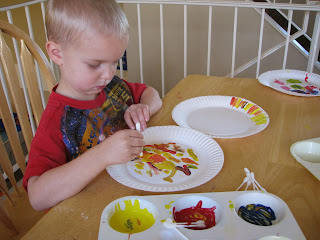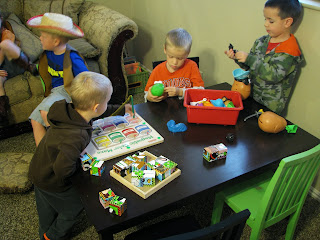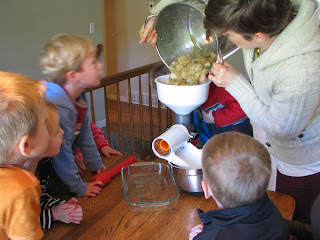Our study topic for November was community. We learned that every person is an important part of a community. We identified community helpers, such as teachers, police officers, firefighters, doctors, builders, postal workers, librarians, etc. We also identified various places in our community. We learned that communities are found all over the world, including cities, suburbs, and rural areas. We studied maps to create maps of our city, our country, and our world. Learning about life in a city was a nice contrast to last month's study topic of farming. I've documented our learning experiences below. Enjoy!
Best,
Teacher April
The children inspired this study topic. I noticed the girls kept removing a map from our wall and incorporating the map into their drama play. They looked at the map to make plans for various excursions, including a trip to grandma's house and a camping trip.
Other children in the building area were creating cities and playing police officer. Thus our study of cities and community helpers was born.
We began our study by reading the classic story The Town Mouse and the Country Mouse to compare life in the city and life in the country. We also compared this book to a similar and more modern version of the story, called The City Kid and the Suburb Kid. (The other great books we read are shown here as well.)
The children could develop their ideas about community further in our dramatic play area, where we had building and construction props. The children were invited to build different places in our community.
The first day the materials were out, the children were all building their own structures (and running out of blocks). At my suggestion, they began to cooperate so they could build larger structures.
Here was the result. They were proud that they had built something so large.
Some days the children built a hospital, and on other days a school or a post office.
I also observed the children take on the roles of various community helpers.They pretended that a builder got hurt on the job and had to go to the doctor. I was very pleased to see the children taking on roles and making plans for their play.
We have been sending and receiving post cards at our school. This month we received a post card from a person in New York City. I challenged the children to build the tallest structure they could. The children began building skyscrapers in the drama play area as well as the building area.
We looked at a book about the world's most amazing skyscrapers for inspiration. By the end of the month, children were becoming quite proficient at building tall structures.Children were also invited to work with water pipes in the sand and water table to build a continuous tunnel for moving water "underground".
Again, children became more proficient at this over time. This underscores the importance of allowing children to work with materials over an extended period of time so they can develop their skills.
We incorporated maps into our study of community as well. Children were given a map of our city and invited to add places in our community.
Some children added grocery stores, restaurants (McDonald's of course), a hospital, our school, their house, etc. They also drew roads to connect the different places in our community.
Several children also chose to do additional map work using a map of our country. They really enjoyed the map work. We added a page to our alphabet book: U is for Utah.
At snack time, one student took a bite of their cracker and said, "Look, teacher, I made Utah!" Other children then joined the fun, taking a bite out of their cracker to make the shape of Utah. I loved it.
Children were introduced to the seven continents on a world map using this beautiful lap quilt. (I commissioned a student's mother to make this for our school. Miriam, I can't thank you enough for this. This handiwork is a beautiful piece of art. Absolutely amazing!)
To complete this activity, children look at the shapes on the map and match each continent to its correct location.The map quilt doubles as a button board (a Montessori-inspired practical life activity). Students button on the continents to complete the map. I have a couple of readers in the group who also added name labels to the continents and oceans.
We celebrated our learning about community by creating a class book that we titled: When I Grow Up. The children each drew a picture of what they wanted to be when they grew up and described why they chose that career.
The class book was placed in our school library, and the children read this book to each other again and again. They loved this.
In preparation for Thanksgiving, we constructed a tee-pee from long branches that we recently cut down from our Cottonwood tree.The children loved playing in the tee-pee and it came in handy when the weather turned cold. We got to have snack time in the tee-pee!
The week of Thanksgiving, we read a story about the first Thanksgiving and discussed how difficult it was for the pilgrims to build the very first community in America. The Native Americans helped the pilgrims and taught them important survival skills, such as how to grow food.
Also in preparation for Thanksgiving we did turkey art. We had a lesson on color-mixing with the goal of creating a turkey with feathers of many different and unique colors.
Children were given the three primary colors, blue, red, and yellow. Then they were invited to do the work of scientists and artists, mixing the colors to discover how many different and unique colors they could create.
I think the personality of each child was reflected in the colors they mixed. It was wonderful to observe the children doing this work.
I think the color palettes the children created were more beautiful than the turkeys! As each child created a new color, I asked "What does that color remind you of?" The children made interesting connections, and were encouraged to name the colors they created. We had hot dog color, pine needle, apple cider, birthday cake, ocean blue, ninja red, spring sun, and bouncing ball. One child appropriately named a rich, brown color turkey color!
Our color mixing investigation was inspired by two students who discovered that when they looked through our window blocks, colors mixed and changed their view of the world. What interesting discoveries will the children make next? Only time will tell. :)
A math skill we focused on this month was rote counting at least to 15. We practice counting each day as we exercise, do our calendar work, and play games together at circle time. We counted the turkey feathers above as an assessment.
A literacy skill we focused on this month was rhyming. We listened for rhyming words in the books we read. The Montessori-inspired work shown here is completed by matching real objects to rhyming picture cards.
Moving outdoors, we said good-bye to our peas and pumpkins. We moved the decaying pumpkins we had been observing to the garden. And they fell apart! This excited the children. One child exclaimed, "Look! They're doing their life cycle!" I loved it.
It was also great to see the children helping each other and cooperating to collect leaves and move them into piles. I hope children have learned from our study of community that everyone can help, and everyone is needed and important.
The weather is changing now. We had our first big snow day of the year. We brought the snow indoors to continue our color mixing investigation. Children were invited to mix liquid water colors to create new beautiful colors for a snow painting.
Not surprisingly, our study topic for December will be SNOW! (and weather in general). We have set up a weather station and have begun collecting weather data. I will share more about that in next month's parent newsletter.
I wish you all a happy holiday season. As always, thank you for sharing your children with me. They are a delight and I look forward to every minute I get to be with them.
Sincerely,
Teacher April























































































































